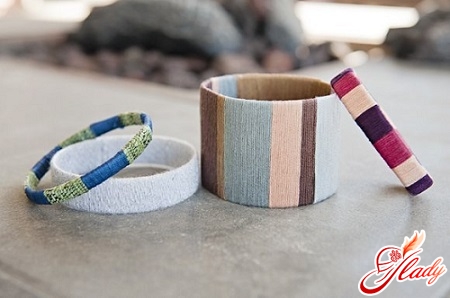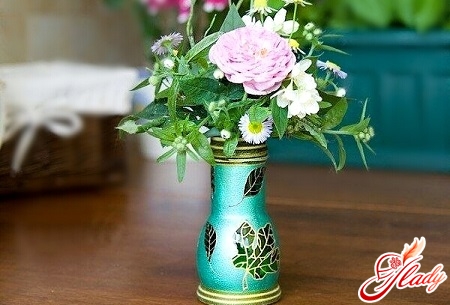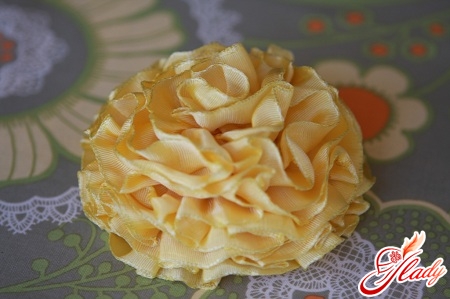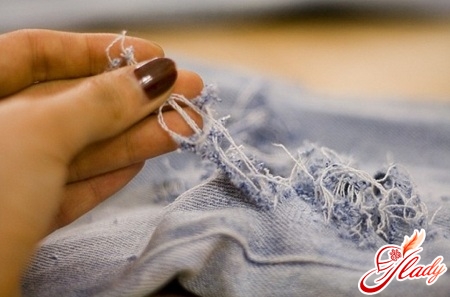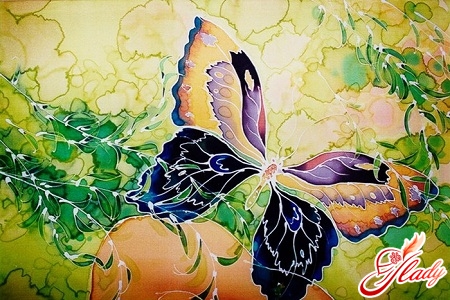 Painting on silk is an ancient and excitingbeautiful art. A huge selection of different colors, pigments and contours helps create great works in a variety of styles. The softness of the flowing fabric, amazing color changes - this kind of needlework can not help but capture. It enables you to create unique and unique fabrics with your own hands. They can be used not only for decorative purposes, but also for creating author's products. It can be an elegant postcard, an art panel and even a delightful exclusive scarf. All these things will bring joy to their creator and to whom they were intended. This technique, as a kind of applied art, has a textile style. Its magnificent example is the traditional Azerbaijani handkerchief, which is made according to ancient technology. The products are mainly created by applying the reserve lines to the fabric, which are the limiters for the dyes. Painting on silk, fabric - batik, is the direction that allows you to create a wide patterned lines, leaving part of the fabric is not painted. For modern and traditional techniques of painting on silk, there is a combination of color spots, lines, ornaments and decorative painting. Most often, textile graphics have a planar character, with no front or back plane on it. In general, there are a number of decorative techniques for silk painting, each of which has its own traditions.
Painting on silk is an ancient and excitingbeautiful art. A huge selection of different colors, pigments and contours helps create great works in a variety of styles. The softness of the flowing fabric, amazing color changes - this kind of needlework can not help but capture. It enables you to create unique and unique fabrics with your own hands. They can be used not only for decorative purposes, but also for creating author's products. It can be an elegant postcard, an art panel and even a delightful exclusive scarf. All these things will bring joy to their creator and to whom they were intended. This technique, as a kind of applied art, has a textile style. Its magnificent example is the traditional Azerbaijani handkerchief, which is made according to ancient technology. The products are mainly created by applying the reserve lines to the fabric, which are the limiters for the dyes. Painting on silk, fabric - batik, is the direction that allows you to create a wide patterned lines, leaving part of the fabric is not painted. For modern and traditional techniques of painting on silk, there is a combination of color spots, lines, ornaments and decorative painting. Most often, textile graphics have a planar character, with no front or back plane on it. In general, there are a number of decorative techniques for silk painting, each of which has its own traditions.
Equipment and materials
Usually, after seeing the magnificent works of masters,many are excited by the desire to try their hand at this business and do silk painting. Such enthusiasts are interested in what is needed for painting on silk. There are a lot of adaptations for this technique, but you can start to practice it, even with only the most necessary equipment.
- Silk
Easy pongee - great material forbeginning artists. This fabric is well suited for training exercises and samplers, as well as for the production of holiday cards, scarves and paintings. In the process of work, as you gain experience, you can try to work with other types of silk fabrics.
- Dyes and paints for silk
- Contoured mixtures and gutta
Drawing of lines serving in the silk paintingbarrier from the spreading of paints on the fabric, is an indispensable element of this technology. Barrier lines are applied with the help of gutta and other contour compounds.
- Thin metal nozzles
There are special metal nozzles that can be attached to the nozzle of the applicator to adjust the thickness of the contour. A nozzle with a diameter of 0.3-1.0 mm is produced.
- Thickeners thickener
To change the way the ink flows to the dye for silk, special thickeners are added.
- Priming compound
It is applied to the fabric in order to change the ability of silk to absorb the dye.
- Effective salts
They are used to obtain spectacular patterns based on changing the texture of the picture.
- Frames
For the convenience of painting silk is stretched on a frame that promotes the correct and even distribution of dyes. More effective are special sliding frames of different designs.
- Instruments
These include cat-hooks for stretching silk on the frame, forms for the colors, flat and round brushes of different sizes, tubes for depositing the reserve, etc. 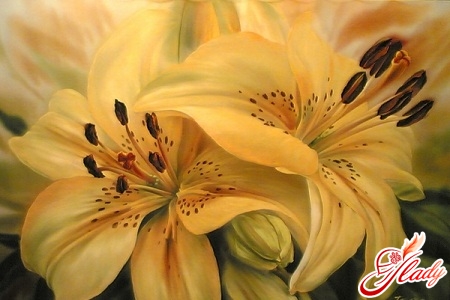
The basic receptions of a list
Virtually all types of silk painting are performedon the fabric stretched over the frame. The first and one of the main stages is the creation of a contour line. It is applied by the reserving staff, which creates an obstacle and does not allow the paint to spread. To get a neat contour line, you need a certain skill that comes with experience. The pattern can be applied with a template or directly by hand. This, of course, is more difficult, but it gives you a certain freedom of fantasy, because you can show your individuality in this way. To create very interesting paintings, you can apply step-by-step drawing of a contour with a colorless reserve. To do this, use the reserve line, which is necessary to control the distribution of dyes and to outline the outline of the pattern. When working in this way, the lines are less noticeable, which leads to the creation of a less patterned and softer image. With the step-by-step application of contours, the decorative role of the line is minimized. But you can create unique patterns using invisible reserve lines. With the help of gutta, wax or water-soluble reserve, you can apply the desired pattern, and then, after painting it, remove the entire contours from the finished product. To obtain clear geometric patterns or curbs, you should learn how to apply straight lines. After a certain practice, they can be drawn by hand. To begin with, you can train by putting a long ruler into two bars. Using thickeners for paints, the pattern on the fabric can be applied using stamps and seals. Beginner masters such auxiliaries can be purchased in a special shop, where there is a sufficiently large selection of finished products with a variety of prints. Experienced craftsmen who create unique patterns make stamps themselves or to order.
- Painting "wet on wet" to create a watercolor effect
When this technique is used,free flow of color. At the moment when the flow of paint over the fabric ceases, a decorative layer is formed, which is called "sagging." If you place water stains in certain places, they can be made part of the picture. Especially beautiful they look in the landscapes, where trees, mountains are depicted. In plant motifs with the help of decorative waxes, you can create the outlines of flower petals and veins of leaves. This is quite a complicated technique, because you need to be able to control the movement of dyes.
- Work with the use of effect salts
Dry salt has the ability to absorb paintor liquid dye, allowing you to create amazing "frosty" patterns. The size of patterned color spots can be adjusted using granules and salt crystals of various sizes. With the help of table salt, you can make very small points, and the use of economic and special effect salt for batik helps to get a larger picture. Salt when working in this technique is scattered on silk, while the paints are still wet. Salt can not absorb the dye and form a pattern if the fabric has already dried. In this case, instead of spectacular fluid divorces, a pattern of small stars will be obtained. An unusual pattern is formed if each zone of salt has its own zone of action. 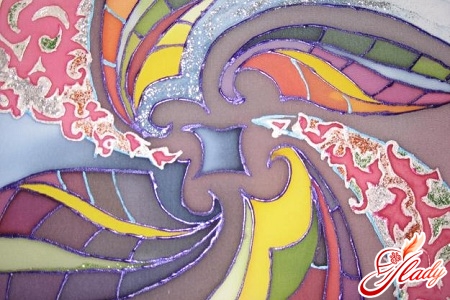
- Use of primers
Thickening compositions change the abilitydye freely flow through the fabric. But you can change the absorbent capacity of the tissue itself. After processing the silk with a special compound that prevents the absorption of liquid, the paints are easily applied to the material even without the use of reserves. Priming formulations are transparent or white. They are applied both to the entire fabric and to a specific area. When the primer dries, silk behaves like a dense, dry paper, keeping the dyes where they are applied. When working, you can adhere to the contours of the sample placed under the fabric or effectively create, following your own imagination. Applying primer mixes gives silk some stiffness, so these products are used where softness and dpiruemost not very important, for example, in panels, postcards, cushion covers.
- Creation of patterns from water divorce
To create the most spectacular zatekov usesequential application on the dry areas of painting layers of vapor-fastened dyes, alcohol, water or dissolving agents. Each subsequent application of a dye or other liquids repels the previous layers of paint, creating so-called "wrinkled edges". If the subsequent layer is applied, when the tissue is still wet, the effect obtained from the waxes softens. In this case, the fabric shows a pattern of lighter lines or elegant rings. Here in brief were listed the main methods of painting on silk, with which you can create magnificent high-artistic products for decorating your home and exclusive fashion accessories for your wardrobe. If you decide to tackle this fascinating business seriously, you will learn other additional techniques where you can work not only with smooth silk, but also with silk velvet. In the meantime, you should learn the basics of skill. And believe me, painting on silk will bring you true creative pleasure! We advise you to read:




